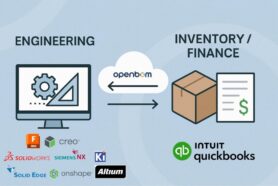
Data is by far one of the most strategic assets in many companies. While almost no one will argue with this statement, it is shocking to see how often manufacturing companies are ignorant to the fact and don’t count how much value they lose when dumping tons of Excels as a solution for data management.
The greatest pain point for many manufacturers is the disorganization of data as there is no single source of product records. Companies demand optimized data processing and organization. Data is often siloed in different physical locations, in engineering, procurement, supply chain management, and customer-facing databases such as disconnected PLM and ERP systems, spreadsheets, and email. This leads to miscommunication between engineers, contractors, and suppliers causing mistakes, delays, excessive cost, lost orders, and other problems.
OpenBOM cloud-based, SaaS platform solves the problem of data management by collecting data from multiple sources and multiple companies, providing product data intelligence, and changing the way organizations work together in product development and manufacturing environments. You can say… Well, these are just words you can hear from almost every vendor today. Who is not focusing on data management?
As I like to say, the devil is in the details. The reason for many companies opting to use Excel is because data is complex and hard to manage. So, they look for ubiquitous characteristics of Excel combined with pseudo-easy ways to control and manage their data. OpenBOM has developed a blend of unique capabilities under the single application platform capable of tackling super complex data management requirements.
Here are three fundamental elements of OpenBOM data management that make it unique.
A Single Source of Data
OpenBOM is a SaaS network-based global collaborative platform that manages product data and connects manufacturers with their customers, contractors, and suppliers. In a nutshell, OpenBOM helps companies organize product information into a single source of truth and enables a new level of collaboration between teams and companies. OpenBOM “connects the dots” and optimizes the processes between multiple organizations, contractors, and suppliers. OpenBOM distributed catalog systems, flexible product structure model and system wide relationship model provide a single data representation while sharing data with the right role-based access.
Multitenancy
The core of OpenBOM is a global, multi-tenant flexible data model. It provides an easy way to organize product data records (extract, integrate, and manage revisions, changes, history, and other information). The data organization is flexible and allows changes to data in real-time. The administration of rights is distributed based on access levels. OpenBOM global data architecture rely on a blend of standard and scalable databases and micro-service architecture combined with real-time collaboration. The most important – data is never copied to be transferred between people and organizations, which is represented by a multi-tenant data model.
Data Focused Thinking
We worked hard to make OpenBOM similar to Excel to mirror its simplicity and ease of use. But as much as OpenBOM looks and feels like Excel, it is not! One of the most typical mistakes is to think that OpenBOM is just a storage place for your BOM spreadsheets. Attempting to add BOMs like files and manage them as spreadsheets that contain data is wrong. You are missing a key component of OpenBOM’s platform — a data management system managing items and product structures. OpenBOM connects multiple pieces of the data in your account by managing items, their data properties, relationships, instances, etc. Think database, and stop thinking about files.
Conclusion
At OpenBOM we developed a bottom-up scalable platform that is capable of managing a variety of manufacturing and engineering data, combining it with robustness, unique collaboration capabilities, and multi-tenancy. Because of these characteristics, OpenBOM can easily scale to support multiple companies and distributed environments.
Check out what OpenBOM can do for you – REGISTER for FREE and explore your 14-day trial.
Best, Oleg
Join our newsletter to receive a weekly portion of news, articles, and tips about OpenBOM and our community.









